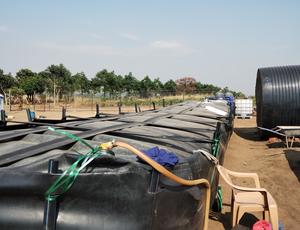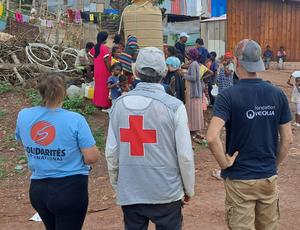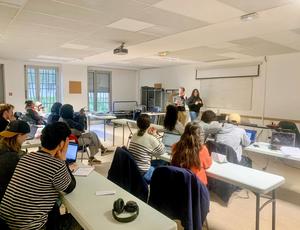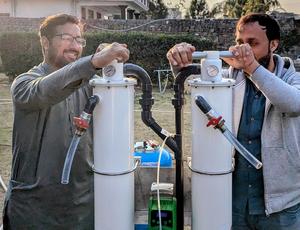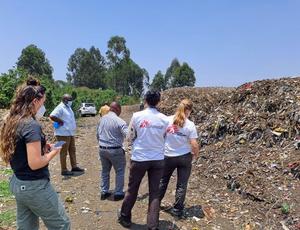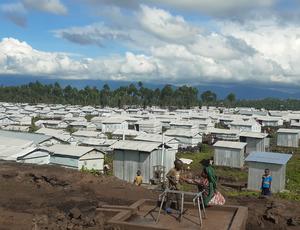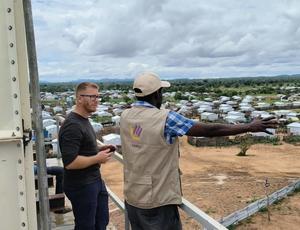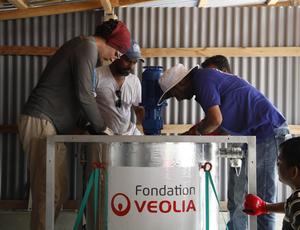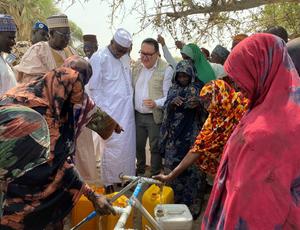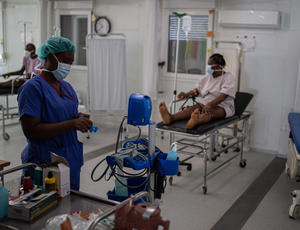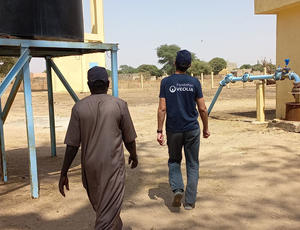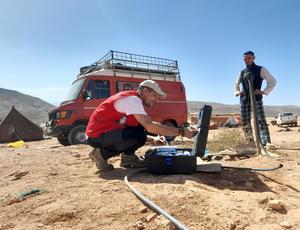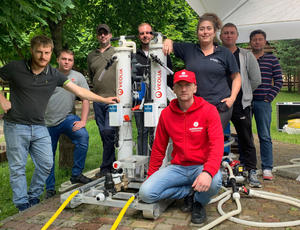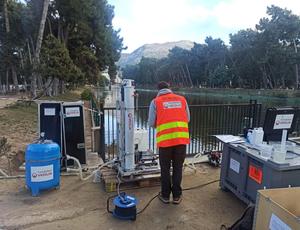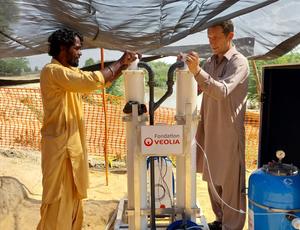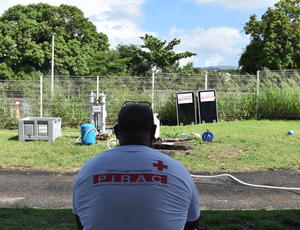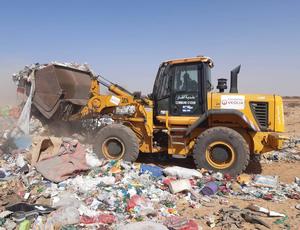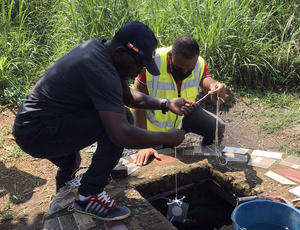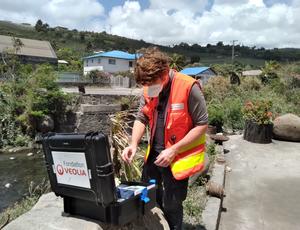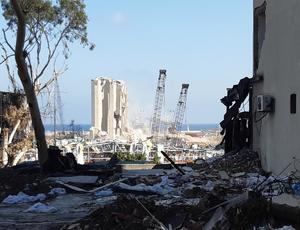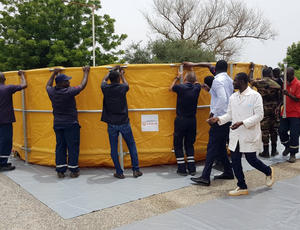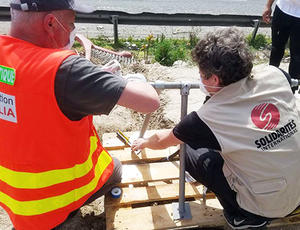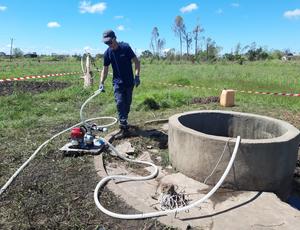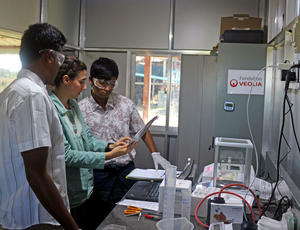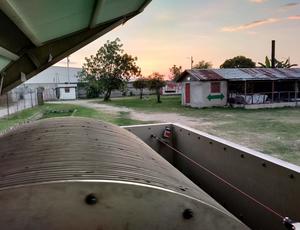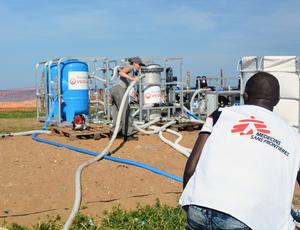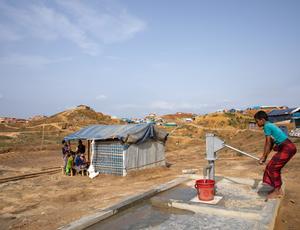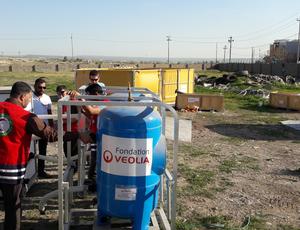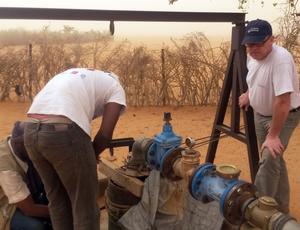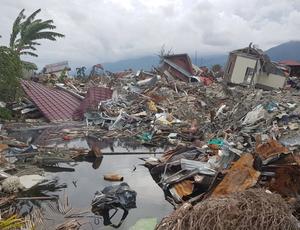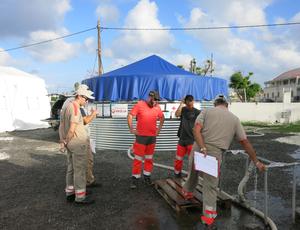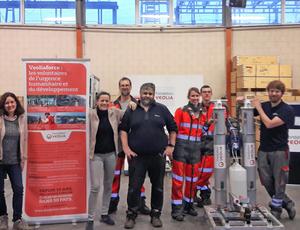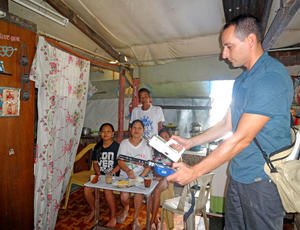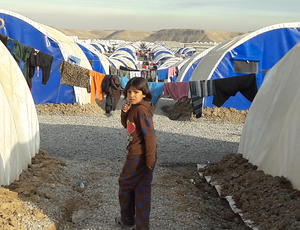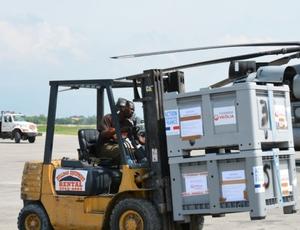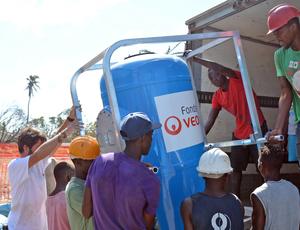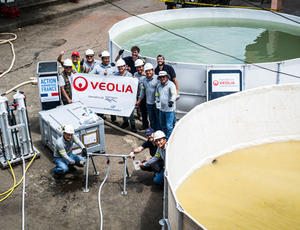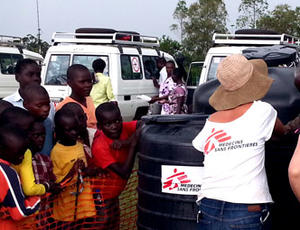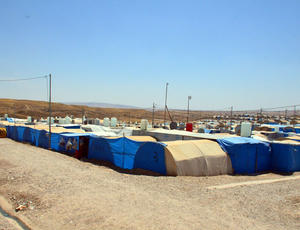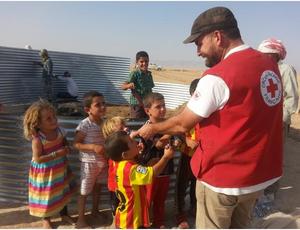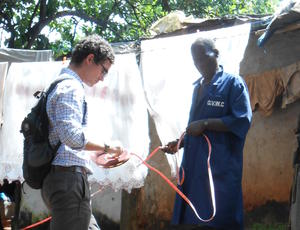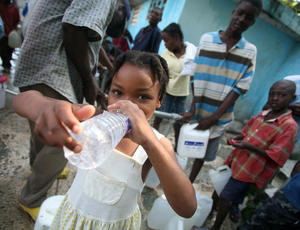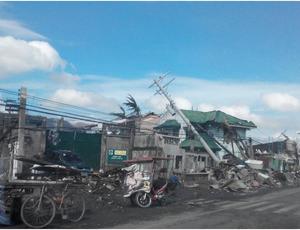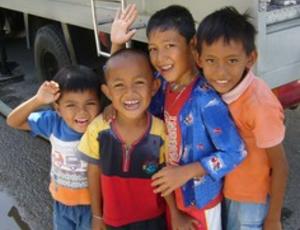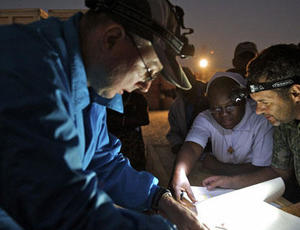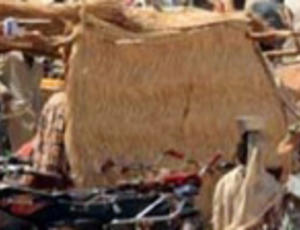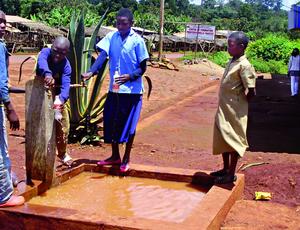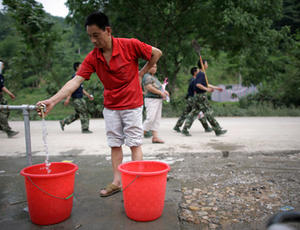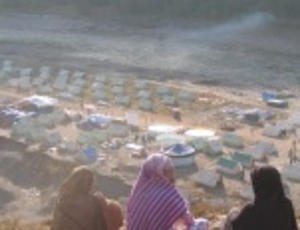Since its creation in 2004, the Veolia Foundation has carried out nearly 250 expert missions, both on development projects and in humanitarian emergencies. Illustrations.
2025
Several Veoliaforce experts have gone to Uganda to deploy a Saniforce pilot with the Ugandan Red Cross. An engineering student from the Brazilian University of Sao Paulo was also present to collect data.
2024-2025
After the devastating passage of cyclone Chido in Mayotte, some twenty Veoliaforce volunteers were assigned to two partner NGOs: the French Red Cross and Solidarités International.
2025
What is CSR / CSR? For whom and why? These and many other questions were put to Quitterie de La Villegeorges. A Veoliaforce volunteer with the Veolia Foundation, she was assigned to train students on these topics for 4 days.
2025
Two Veoliaforce volunteers were mobilized in Pakistan to train Médecins Sans Frontières staff in the deployment of Aquaforces 2000, which had been in storage since the 2022 intervention following the floods that devastated the country.
2024
As partners in their humanitarian commitment, the Veolia Foundation and Médecins Sans Frontières (MSF) are working to improve the NGO's waste management in the areas where it operates, notably in the DRC and neighboring Rwanda.
2024
In Goma, in the east of the Democratic Republic of Congo, Médecins Sans Frontières operates hospital structures and works in camps for displaced persons. Alongside it, the Veolia Foundation is stepping up its efforts to improve access to drinking water.
2024
A Veoliaforce mission for the UN High Commissioner for Refugees (UNHCR) to audit a dozen camps around Farchana, in the east of the country, and make recommendations to improve access to water.
2024
In Cox's Bazar, Bangladesh, the Veolia Foundation is working with the International Organization for Migration (IOM) to install a pilot fecal sludge post-treatment system near refugee camps.
2024
A UNICEF / Veolia Foundation collaboration to deploy Aquaforces 2000 in the communities of Baga Sola and Bol, located on the shores of Lake Chad, and train staff in their use.
2022-2024
Identification of a bacterium in the pipes of a hospital, definition of sampling protocols and an action plan to treat the contamination. OFIS expertise (SARP, Veolia) mobilized remotely.
2024
Deployment of an Aquaforce RO to treat excessively high fluoride levels, leading to several Veoliaforce missions.
2023
Rotation of four Veoliaforce experts, deployed by the French Red Cross via the International Federation of Red Cross and Red Crescent Societies, after the earthquake on 8 September.
2023
Following the destruction of the Kakhova dam in Ukraine, Aquaforces and a volunteer were sent to train Solidarités International teams in their deployment.
2023
Mobilisation of two Veoliaforce experts to work with colleagues from Veolia Water Technologies (VWT) Turkey following the earthquake that struck Turkey on 6 February 2023.
2022
Provision of Veoliaforce expertise and mobile water purification units after deadly floods.
2022
Veoliaforce mission, carried out with the French Red Cross, in particular the Americas Caribbean Regional Intervention Platform (Pirac), to ensure the distribution of drinking water to households in Vieux-Habitants using an Aquaforce 2000.
2021
Local teams trained and new vehicles to collect waste in Atar, Mauritania.
2021
Mission of an expert from Veolia's Scientific and Technological Expertise Department (DEST) to take samples and send them for analysis of water potentially contaminated after the explosion of a munitions depot in Bata.
2021
Mobilization of a Veoliaforce expert with his mobile analysis laboratory to analyze the impact of ash on water quality after the eruption of La Soufrière, in the south of the French West Indies.
2020
After the devastating explosion on 4 August 2020, a diagnostic mission followed by rotations of Veoliaforce volunteers to search for leaks in the water network.
2020
With the Société d'exploitation des eaux du Niger (SEEN, Veolia), Veoliaforce volunteers deployed three Aquaforces 5000, mobile water purification units, to supply water to people affected by the floods in September 2020.
2020
Provision of temporary access to water in unsanitary camps in the Paris region, following a needs assessment phase with Solidarités International.
2019
Mobilization with the French Red Cross, Médecins Sans Frontières and Solidarités International, to send a dozen Veoliaforce volunteers to deploy water purification equipment.
2018-2020
Optimization and adaptation of the wastewater treatment plant at the Sittwe camp for displaced persons. Two Veoliaforce missions, on-site and remote, in 2019 and 2020.
Since 2018
Development of a solution to treat wastewater from the hospital in the Drouillard district of Port-au-Prince.
2018
First deployment of the Aquaforce 15000 to supply a refugee camp run by Médecins Sans Frontières.
2018
Support for the water supply in the Kutupalong-Balukhali camp (Rohingya refugees), along the Burmese border in Bangladesh.
2018
For three weeks, two Veoliaforce volunteers trained members of the Iraqi Red Crescent to use water supply solutions in emergency situations.
2018
Intervention in partnership with UNHCR to study the hydraulic network of a refugee camp located in Mbera, on the border between Mauritania and Mali.
2018
After an earthquake followed by a tsunami in Indonesia in September 2018, mobilization of the Veolia Foundation as part of the mechanism steered by the crisis and support center (CDCS) of the French Ministry of Europe and Foreign Affairs.
2017
Emergency water production and setting up of water distribution points before re-establishing network connections.
2017
For three days, some fifteen volunteers from the Paris region lent a hand to the Foundation's team mobilized at the Massy warehouse to pack materials for future emergency interventions.
2017
Mission carried out with Médecins du Monde to take stock of environment and health issues (water and air quality, waste management and sanitation) in a shantytown in the capital of the Philippines.
2016
Intervention alongside the French Red Cross and the Qatari and Iraqi Red Crescent to supply drinking water to the Khazer 2 camp, located 30 km east of Mosul in Iraq.
2016
In the days following the hurricane, the French NGO ACTED asked the Veolia Foundation to organize an emergency humanitarian mission. This was the beginning of a mobilization of Veoliaforce equipment and volunteers.
2016
After Cyclone Idai hit Mozambique, Malawi and Zimbabwe in March 2019, the Veolia Foundation intervened. Together with the French Red Cross, Médecins Sans Frontières and Solidarités International, it mobilized by sending equipment and a dozen Veoliaforce experts.
2016
An intervention in partnership with Interagua after the worst earthquake in Latin America since Haiti in 2010: the quake hit the Pacific coast of Ecuador.
2015
Training of Médecins Sans Frontières staff and deployment of an Aquaforce 500 mobile water treatment unit to supply water to a mobile health centre run by the NGO.
2014-2015
After carrying out an initial intervention with the French Red Cross in the summer of 2014 to provide assistance to displaced persons, the Veolia Foundation has once again mobilized by taking part in an assessment mission to the Bardarash camp led by the French Ministry of Foreign Affairs. A Foundation volunteer went on site in August.
2014
In Iraq, the war against Daech (Islamic State) led to population displacements and thousands of refugees arrived in Iraqi Kurdistan during the summer of 2014. The Veoliaforce volunteers who took turns on the ground organized the supply of drinking water and the construction of latrines at around forty sites dedicated to housing Iraqi refugees located outside the camps.
2014
To combat cholera in Sierra Leone, installation of a chlorination system on the distribution network in Freetown, where Action Contre la Faim is running a program to improve water quality in the capital's vulnerable neighborhoods, which are regularly hit by cholera epidemics.
2010-2013
The Veolia Foundation mobilized immediately after the earthquake that hit Haiti on January 12, 2010. It intervened in the emergency and post-emergency phases, then remained mobilized around a program to rehabilitate the water network in the town of Petit-Goâve in Haiti.
2010
Uncontrolled exploitation of gold mines pollutes Nigerian soil and threatens the health of local populations.
2013
Installation of Aquaforces 500 mobile water purification units and a distribution system (ramps and flexible tanks). Assessment of networks and water treatment plants after the passage of a cyclone. (rampes et réservoirs souples).
2009
Evaluation of waste disposal in areas affected by tropical storm Ketsana.
2009
Last December, a multi-ethnic conflict in the Democratic Republic of Congo led to major population movements: between 80,000 and 100,000 people crossed the border into Congo Brazzaville and CAR.
2009
On September 30, 2009, a violent earthquake measuring 7.6 on the Richter scale devastated the Indonesian island of Sumatra, severely damaging homes and water infrastructures.
2008
Veoliaforce intervention as part of the partnership with UNICEF after the passage of four hurricanes between August and September 2008. Mission in Gonaïves, in the northwest of Haiti, the region hardest hit by flooding after four hurricanes.
2008
Following the attack by the rebel troops in Chad, 8000 refugees have been accommodated in a UNHCR camp at Maltam (Cameroon) where a Red Cross health structure provides first aid.
2008
Fay, Gustav, Hanna, Ike ... In three weeks, in late August and early September, these large scale hurricanes devastated the coast of the island of Haiti, where 70% of the population live below the poverty line.
2006-2015
Seven drinking water networks rehabilitated (20 boreholes, 12 water towers and 200 standpipes), complemented by 15 ecological latrines, including 10 in schools and 5 in markets. In addition to the work on the infrastructure, it is above all the training of a motivated technical department in the Bangangté commune and the setting up of management committees in the villages that will enable these facilities to function.
2008
On 12 May 2008, a magnitude 8 earthquake on the Richter scale ravaged the province of Sichuan, in the center of China: 80,000 dead, 20,000 disappeared and 1,500,000 victims.
2005
Deployment of Aquaforce and water supply for six months.
2004
Deployment of Aquaforces 5000; complete rehabilitation of the Meulaboh regional hospital distribution network.


